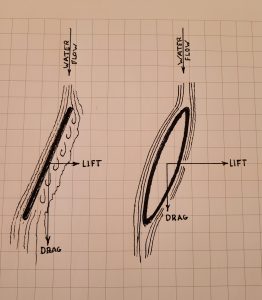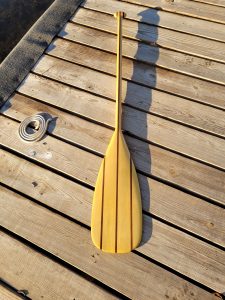By Roy Ivey
My favorite Physics professors, in their early years, were skilled canoeists. Canoeing, it seems, was responsible for much early scientific discovery. In fact, while these bright men held different ideas on paddle design, they had common goals in developing the most responsive hydrofoils and airfoils.
 Unlike airplanes with wings, propellers, and rudders, the canoe has only the paddle to move it and control it. A good paddle must perform all these functions as efficiently as possible.
Unlike airplanes with wings, propellers, and rudders, the canoe has only the paddle to move it and control it. A good paddle must perform all these functions as efficiently as possible.
In my freshman year Dr. Newton described his ideal paddle. It was thin and relatively flat with sharp edges. When he placed it in the water beside the moving canoe, it “knifed” cleanly. And when he “opened” it to a slight angle of attack, the boat followed. He attributed this motion to the force of the water impinging on one side of the blade. This early research ultimately led to his now-famous Third Law of Motion. Isaac Newton was a great professor.
Some years later I studied “Hydrodynamica” with Professor Dan. He said that we should disregard the teachings of Isaac Newton. It seems that Dan’s favorite paddle was not flat. In fact, it was thicker with an elliptical cross section. With this thicker design, oddly, his paddle seemed to “knife” with less drag. And, when opened to an angle, it caused the water to flow more smoothly over the blade causing a difference in pressure between the two sides and pulling the boat to the side. When compared to the flatter blade, the canoe seemed to follow with greater authority. The elliptical shape could handle a greater angle of attack without cavitating. Professor Daniel Bernoulli got me thinking. Isn’t that the purpose of education?

Years later when I was seeking STOL (short take-off and landing) aircraft certification, I was fortunate to learn from the best. In fact, at one time, my instructor had held the world record for the slowest powered flight. He explained the advantage of a cambered (elliptical) wing in STOL aircraft. He suggested that a flying wing emulates a paddle in water. In this regard, he used the word “lift” for the force applied by both, airfoils and hydrofoils. He explained that an increase in lift produces an increase in drag. In fact, the Lift-to-Drag Ratio of the elliptical shape was higher than that of the flat shape. Though not a paddler, Orville suggested that, for paddling, an elliptical blade might provide more lift and therefore, more control.
I was not the only one who learned a thing or two from Orville Wright. During his early studies, Orville had designed a rudimentary wind tunnel to evaluate the lift-to-drag ratios of various airfoils. Walter Chrysler conferred with Orville in the building of a wind tunnel to evaluate wind resistance (drag) in automobiles. Chrysler built his full-scale wind tunnel in Highland Park, Michigan. It ultimately became instrumental in automotive design including the innovative Chrysler Airflow.
 I decided to use Bernoulli’s Theorem and the Wright Brothers’ experience as a basis for developing the perfect FreeStyle paddle. I asked our son, Jon, to use his woodworking skills to build a paddle of unique design. Jon’s paddle is thick with an elliptical cross section.
I decided to use Bernoulli’s Theorem and the Wright Brothers’ experience as a basis for developing the perfect FreeStyle paddle. I asked our son, Jon, to use his woodworking skills to build a paddle of unique design. Jon’s paddle is thick with an elliptical cross section.
The results were amazing! Admittedly, it takes some “getting used to”. It seems to have a mind of its own. Hang on! It wants to go the way it is “aimed”, no matter what. It can handle a greater angle of attack than the Newtonian paddle without cavitating. Perfect paddle placement becomes critical. And the boat responds with great authority. Isn’t that the goal in FreeStyle?
We were so pleased with Jon’s paddle that we asked him to build another. This summer Peg and I used a pair of Jon’s innovative paddles in three FreeStyle exhibitions; the perfect example of applied physics!
Sure, there is room for more discussion and experimentation. But I think Jon’s Bernoulli blade is a great starting place for the perfect FreeStyle paddle. Let’s paddle!